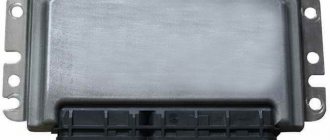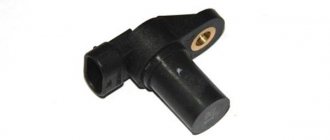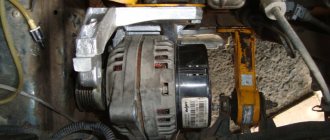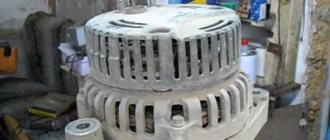The efficient operation of VAZ vehicles directly depends on a well-functioning exhaust gas removal system. It is impossible to imagine fuel combustion without an exhaust system, which ensures the normal functioning of a car engine. At the same time, the design of pipes of various sections is distinguished by its simplicity.
It prevents gases from entering the cabin, suppresses sound vibrations of the engine and reduces waste toxicity. Since the “health” of the entire car depends on the reliable operation of the muffler, its owner needs to know the design of the exhaust system as a whole. Let's look at the VAZ 2114 muffler in more detail in the review.
Muffler VAZ 2114
Exhaust system design
The functional structure of the exhaust system is designed in such a way as to reliably regulate the removal of chemical waste outside the vehicle.
VAZ 2114 muffler diagram
The gas exhaust structure consists of the following components:
- Exhaust manifold. Designed to unify gas cylinders into a single system. Its mounting must be sufficiently rigid to cope with dynamic loads.
- Catalyst. Designed to convert harmful chemicals into gaseous impurities that are safer for human health. The need to reduce gas toxicity is determined by environmental standards for mobile vehicles.
- Reception pipe. Connects the two previous components of the gas exhaust structure.
- Resonator. Its immediate function is to reduce the noise level emitted by the exhaust system. This is achieved through special acoustic mirrors. However, this structural element is a rather vulnerable point in the overall mechanism, since it is constantly exposed to high temperatures. Stainless steel can simply burn through. Therefore, it must be periodically welded with electrodes, or the resonator must be replaced.
- Muffler 2114. Also contributes to noise absorption during engine operation.
- Corrugation. An elastic hose is necessary to suppress mechanical vibrations produced by the engine. Over time, the corrugation structure stretches, forcing the owner to replace it.
, , .
| 2109 , 2114 | 18:51, 17 20 |
| 2114 | 17:58, 13 187 |
| 14:26, 11 782 | |
| 08:33, 7 667 | |
| VAZ 2114-2115 2003-2113 VAZ 2114-2115 2114, 2113, VAZ 2114-2115 … | 20:37, 96 |
| 2114 (2008.) LADA .21144120002000 | 22:53, — … |
| 2114 ( ) «» . () | 07:00, |
| 2113, 2114 () | 07:00, |
| 2114 . () . | 07:00, |
| 2114 LADA. | 06:57, |
| -2114 «» / | 19:48, 1001z |
| -2109, 2113, 2114, 2115 ( ) (1570) «» / | 19:47, 1001z |
| -2109, 2113, 2114, 2115 ( ) (1200) «» / | 19:47, 1001z |
| VAZ 2114-2115 2003-2113 VAZ 2114-2115 2114, 2113, VAZ 2114-2115 … | 20:35, 96 |
| VAZ 2114-2115 2003-2113 VAZ 2114-2115 2114, 2113, VAZ 2114-2115 … | 20:36, 96 |
| VAZ 2114-2115 2003-2113 VAZ 2114-2115 | 20:35, 96 |
| 2114 | 20:34, Autoko - ... |
| 2114 | 20:34, Autoko - ... |
| VAZ 2114-2115 2003-2113 VAZ 2114-2115 2114, 2113, VAZ 2114-2115 … | 20:39, -96 |
| VAZ 2114-2115 2003-2113 VAZ 2114-2115 2114, 2113, VAZ 2114-2115 … | 20:36, 96 |
| VAZ 2114-2115 2003-2113 VAZ 2114-2115 2114, 2113, VAZ 2114-2115 … | 20:35, 96 |
| 2110, 2112,2108-2115 | + 16:15, 9 360 |
| 2115 | + 15:47, 9 91 |
| 2115 | + 15:45, 9 69 |
| 21144 ( 2114 2008. ) , : , : , ( ) | 11:17, FORWARD |
| () 2114 / , : , : , ( ) | 11:15, FORWARD |
| () | 07:05, |
| LADA .200108027R Oz_ | 01:17, — … |
| Lada Granta 2011> … 2011> 5-790 BAZ21126 BAZ2112 BAZ211 BAZ21 … , 5-7 | 17:39, |
| ( ) logan/sandero LADA .6001547473 Oz_ | 04:57, — … |
Types of car mufflers
Units can be classified according to the material from which they are made. The most popular mufflers are from:
- aluminized steel;
- stainless;
- and so-called direct-flow ones.
Stainless steel muffler
The stainless steel option is considered the most popular, since it is characterized by its simplicity and budget cost. The universal muffler for the VAZ 2114 can also be installed on other vehicle models.
A more expensive option is a device made of aluminized steel. However, its advantage is that such a muffler can last much longer. Often their production is carried out after an individual order.
Attention! The direct-flow device is used on cars intended for sports competitions. Its design is developed in such a way as to give the car high-speed properties. Moreover, the material for its manufacture is also stainless steel.
Diagnostics and replacement
The exhaust gas system of the VAZ 2114 signals problems with extraneous noise. If the muffler is knocking, it means that there is most likely a crack in it. It is worth noting that the volume of noise directly depends on engine speed and load on it. Such a malfunction can be eliminated either by replacing the damaged part or by welding. Experts recommend the first option.
Replacing a muffler begins with carefully selecting a new exhaust system kit. It is strongly recommended to use only original samples from the manufacturer. Otherwise, if for some reason a muffler was chosen on a VAZ of a different design, different from the original, the car owner will have to re-adjust the power system.
After the VAZ 2114 muffler has been purchased, the car must be installed on an inspection pit (overpass). The bolts connecting the crimp coupling should be moistened with a special process fluid, type WD. If you don't have it on hand, you can use motor oil or brake fluid.
This will make it possible to eliminate coking of threaded connections and relatively easily, using wrenches, dismantle the VAZ muffler. Then you need to remove the ferrule and the O-ring. After this, all that remains is to remove the muffler from the special rubber pads and remove it from the system.
Installation and fastening of a new element to replace the old one is carried out in the reverse order. After completing the entire operation, you should turn on the car engine and check whether the muffler is knocking or not.
Malfunctions of the gas exhaust system
Since dynamic load and high temperatures are regular companions of a car muffler, its possible failure should not surprise anyone.
The performance of the exhaust system design is also influenced by the following factors:
- excessive heating of the unit due to fuel combustion can lead to overheating of the system;
- equally rapid cooling also does not benefit the unit. Temperature fluctuations negatively affect its functioning;
- constant vibrations due to engine operation;
- formation of corrosion of steel material;
- mechanical defects of the device resulting from impacts, scratches or chips;
- lack of reliable coating to protect the outside of the unit;
- muffler contamination.
Muffler malfunctions
These factors gradually lead to disruption of the exhaust system as a whole. Using the example of ordinary mechanical damage, one can easily imagine the consequences: a fast gas flow will instantly find a weak spot and, under pressure, begin to systematically expand the hole.
The owner will realize that the integrity of the system has been compromised quite quickly, as the muffler will begin to characteristically knock and growl. A strong grinding sound is eloquent evidence of a breakdown, which greatly simplifies the diagnosis of the problem.
Further operation of the emergency system is strictly not recommended. This is due to the fact that the operating mode of the engine will depend on the normal operation of the muffler.
Attention! In this case, the car owner must accurately identify the faulty area in order to investigate the nature of its occurrence. It is quite possible that replacing the VAZ 2114 muffler may not be necessary. In this case, only repairs of individual system components are carried out.
Connecting elements of the structure
The design of the exhaust system of the VAZ 2114 includes elements that connect its parts into a single and continuous “pipeline”: 1. Sealing gasket - connects the exhaust pipe and the manifold. 2. Movable hinge – used to connect the converter flange and the exhaust pipe. 3. Metallographic ring - installed between the flanges. 4. Cone rings and a clamp with flared ends are the connecting parts between the muffler pipes. 5. Nuts (disposable) on the walls of the bracket and studs of the manifold - secure the exhaust pipe. Let's look at what parts the VAZ 2114 exhaust system consists of in more detail.
Gas exhaust system repair
The above-mentioned mechanical deformations often cause suspension ruptures. These elements are designed to hold detachable tubes under the bottom of the car. But for a burnout to form, it is enough not to notice the development of corrosion on the device. The protective system installed at the factory is not a panacea, and is rather of a formal nature. The accumulation of condensate and exposure to temperature changes can quickly damage the muffler.
Muffler repair
Other reasons include problems with ignition and unstable operation of the catalyst. The latter leads to the fact that the remains of unspent fuel enter the device, where they are exposed to high temperatures. As a result, explosive situations arise that lead to burnouts. Malfunctioning resonators can also lead to the need for exhaust system repairs.
Reasons for part failure
The muffler is affected by several different factors that can lead to failure, these are:
- Atmospheric precipitation, dirt. Precipitation means the occurrence of rain and snow. A mass that periodically falls on a hot pipe causes temperature changes, destroying the strength of the metal. Unfortunately, it will not be possible to protect the muffler in any way; moisture will in any case affect the metal. A smart solution would be to avoid driving through deep puddles and drive slowly on contaminated sections of the road. If the muffler and pipe are dirty, it is necessary to clean it with water (you can use a pressure jet from a hose). After cleaning, it is recommended to start the engine so that any water that has entered the muffler evaporates.
- Condensate. When the unit is idle for a long time, condensation forms in the muffler, causing a corrosive process. This leads to inevitable destruction of the internal parts of the muffler. This happens extremely rarely, but before the trip it is recommended to increase the operating speed by pressing the accelerator several times. The flow of exhaust gases removes moisture from the silencer.
- Chemical influence. As a result of the release of exhaust gas, a lot of toxic chemical particles settle on the walls of the muffler, destroying the metal, and allowing road reagents to get into the muffler.
- Physical influence. Hitting stones and blows from the muffler when driving on roads also lead to a lot of damage.
The chemical and physical effect on the muffler metal is a natural process. It will not be possible to disassemble and clean the muffler, since the container cannot be opened, and only the attention and professionalism of the driver on the road will help protect it from impacts and stones. Diagnosing and repairing minor damage at the initial stage will help avoid serious problems in the future.
The influence of various negative factors can lead to damage to the corrugation or other parts of the muffler
Tuning the gas exhaust system
The exhaust system of the VAZ 2114 also allows you to increase the power of the vehicle's power unit thanks to the installation of forward flow. The engine is boosted by accelerating the exhaust gases.
The principle of operation of direct-flow systems involves the creation of a rarefied atmosphere in which flows flow faster from the combustion chamber into the fuel cylinders. Increasing speed proportionally increases power, creating the necessary resistance.
Its value reaches about 10% above what is initially included in the technical characteristics of the exhaust unit without a direct-flow unit.
Muffler tuning
In a standard muffler, the resistance rate is much higher - 60-70%, which significantly slows down the release of exhaust gases. Equipping with such a unit also increases engine power by 6%. It is important to note that this happens without any structural changes to the gas exhaust system, which often require substantial investment.
Exhaust system of VAZ 2114, VAZ 2115, VAZ 2113
Engine malfunctions, assembly and disassembly of the Lada 2113 engine, gas exhaust system, power unit of the Lada 2114, Lada 2115. Stages of assembly and disassembly of the VAZ 2113, VAZ 2115, VAZ 2114 engine. Exhaust gases Stages of assembly and disassembly of the VAZ 2114, VAZ 2115 engine, VAZ 2113 do-it-yourself disassembly and assembly, do-it-yourself troubleshooting of the cylinder block, repair and replacement of the connecting rod and piston group, design, photo of the cylinder head, maintenance and inspection of the camshaft, design and installation of the lubrication system, repair of the cooling system, design of the fuel system, repair
Diagram for 1.6 l engines
The exhaust system of cars equipped with 1.6 liter engines is distinguished by the fact that it does not contain a neutralizer; this element is replaced by a metal “corrugation”. The exhaust system of the 1.6-liter VAZ 2114 is also equipped with a catalytic manifold, which is mounted after the sealing gasket (3). Let's add a few words about the fastening of the entire structure - it is suspended from the bottom of the car on five suspension cushions, and its component parts are connected to each other using gaskets, O-rings and clamps. And some more information for your information - the exhaust system of VAZ 2115, 14, and 13 has a toxicity standard of R 83.
Features of the catalytic converter
Catalysts began to be installed only on injection engines and with their help achieved more complete combustion of the mixture in the chamber. The VAZ 2114 catalyst consists of a housing, an oxygen sensor, a lambda probe, and a mesh made of special wire, which could help burn out the remaining fuel entering the exhaust system. At the inlet of the catalyst there is an oxygen sensor, which monitors the proportion of oxygen in the exhaust gases, comparing it with atmospheric pressure.
When gases entered the catalyst, the lambda probe assessed the composition of the gas and supplied information to the electronic control unit. The ECU, in turn, adjusted the composition of the mixture so that the content of harmful substances did not exceed the norm. This could go against the engine's requirements for achieving maximum power, but toxicity standards were put at the forefront. The only positive properties of the catalyst include slightly reduced fuel consumption. Although this indicator entirely depends on the condition of the catalyst. The scheme with one lambda probe complied with Euro 2 standards, but today this scheme is already outdated and is no longer used on new cars.











